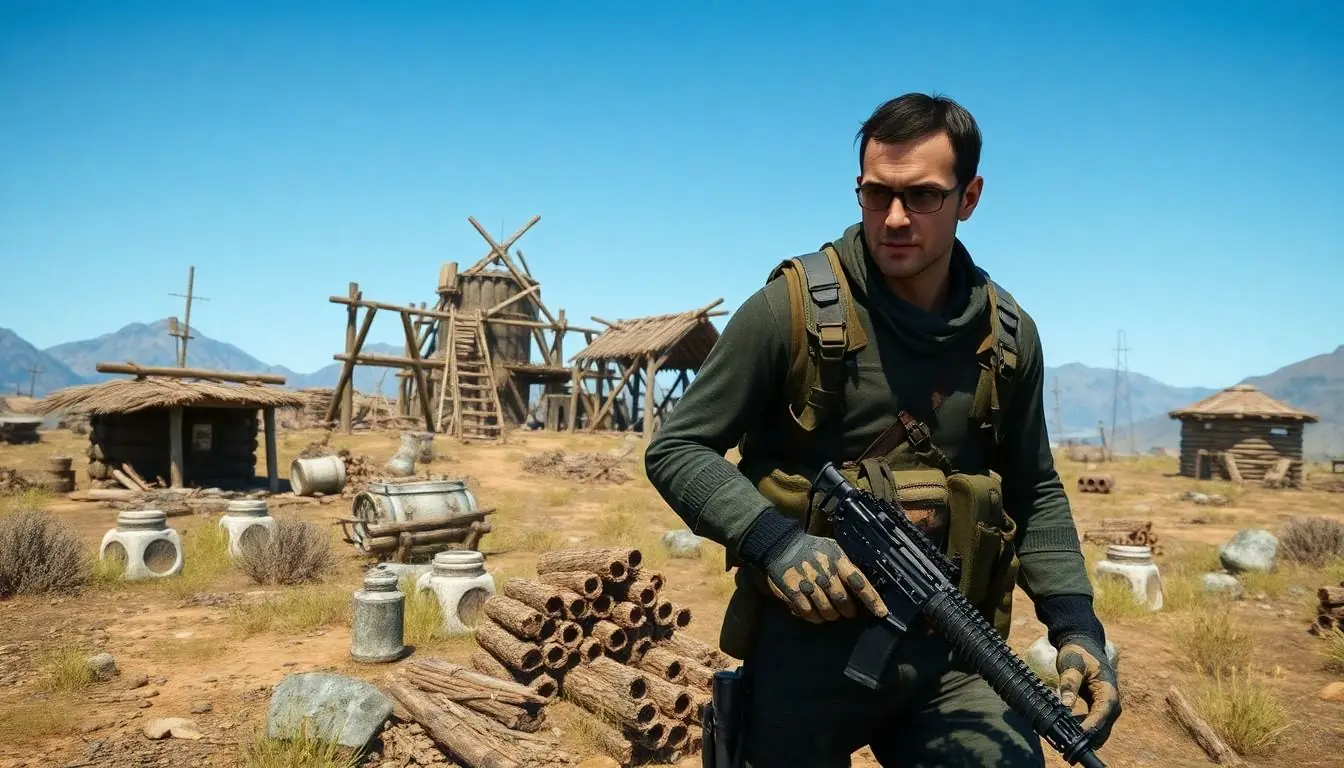In a world where survival isn’t just a game but a way of life, Rust throws players into a chaotic mix of crafting, building, and, let’s be honest, a bit of sneaky betrayal. Picture this: you start with nothing but a rock and a dream, and somehow, you’re expected to fend off wild animals, rival players, and the harsh elements. It’s like camping, but with a lot more yelling and fewer s’mores.
Whether players are teaming up to create a fortress or plotting the ultimate heist, Rust challenges them to think strategically and act swiftly. It’s not just about survival; it’s about thriving in a world where trust is as rare as a unicorn. Get ready to dive into the gritty, unpredictable universe of Rust, where every moment is a test of wits, skill, and the occasional poorly timed joke.
Table of Contents
ToggleOverview Of Rust The Game
Rust stands out as a multiplayer survival game developed by Facepunch Studios. Players begin their journey in a harsh open world, equipped only with a rock and a torch. Navigating threats swiftly becomes essential, as both wildlife and hostile players present constant dangers.
Crafting forms a core mechanic. Resources become crucial for survival, and players gather materials like wood, stone, and metal. Constructing buildings and creating weapons allows for strategic advantages. Teams often form, enhancing gameplay through collaboration and shared resources.
Betrayal frequently adds tension. Players may choose cooperation, yet trust remains a rare commodity. Choices drive experiences, whether through forming alliances or launching surprise attacks on others. Every interaction contributes to the game’s dynamic environment.
Environmental factors also play a significant role. Players must adapt to changing weather patterns and natural obstacles. Managing health and hunger becomes vital, as neglecting these can lead to quick demise. Crafting tools and gathering resources assists in overcoming these challenges effectively.
Regular updates from developers ensure consistent gameplay improvements. Players receive new content and features, keeping the game fresh and engaging. Community feedback drives many enhancements, reflecting player needs and interests.
Overall, Rust combines elements of survival, strategy, and social interaction. Each match presents unique scenarios and varying player behaviors, creating a chaotic yet thrilling experience that deeply immerses participants in the gameplay.
Gameplay Mechanics
Rust emphasizes strategic gameplay centered around survival and resource management. Players encounter various mechanics that require skillful execution and adaptability.
Building and Crafting
Building and crafting dominate Rust’s gameplay. Players collect resources like wood, stone, and metal, enabling the construction of bases and essential items. Each blueprint acquired unlocks new possibilities, enhancing capabilities. Players experiment with architectural designs to create secure environments. Crafting tools, weapons, and armor becomes vital for protection and efficiency. Mastering these skills contributes significantly to a player’s survival chances in hostile territories. Scavenging for components and managing inventories adds depth, as planning becomes crucial to optimize crafting opportunities.
Survival Elements
Survival elements encompass health, hunger, and environmental challenges. Players manage food sources and hydration to maintain health levels. Natural threats such as wildlife pose dangers, while other players heighten risks through combat encounters. Weather conditions impact player strategy, demanding adaptability to stay alive. Crafting clothing and building shelter offer protection from harsh environments. Gathering resources proves essential for sustaining life and thriving within the game. As players navigate these elements, decision-making becomes fundamental, shaping each interaction and experience.
The World Of Rust
Rust immerses players in a harsh, post-apocalyptic world filled with various environments and challenges. Every zone presents unique resources, dangers, and opportunities.
Environment and Zones
Players explore diverse terrains, including forests, deserts, and icy mountains. Each environment influences survival strategies and resource availability. Coastal areas often offer abundant fish and wood, while deserts challenge players with limited water and shelter. Harsh climates require preparation against temperature extremes. Navigating abandoned structures and decay introduces both risks and potential rewards, as valuable loot awaits those willing to search. Engaging with these zones demands keen observation and adaptability to succeed.
PVP and PVE Elements
Rust features a compelling mix of player versus player (PVP) and player versus environment (PVE) elements. Players encounter both wildlife threats and other players, making each interaction unpredictable. Hostile creatures, such as bears and wolves, require players to defend themselves while scavenging for resources. Engaging with other players can lead to alliances or betrayals, significantly impacting survival chances. Players often face the choice of cooperation for mutual benefit or competition for limited supplies. Balancing this dynamic keeps each encounter tense and exhilarating, ensuring every match differs in experience and strategy.
Community and Multiplayer Experience
Rust thrives on the interactions among its players, facilitating a diverse social landscape. Players often encounter each other in various scenarios, which can lead to alliances or conflicts based on decisions made in the moment. Communication forms the backbone of these interactions. It’s common for players to use voice chat, fostering collaboration or negotiation, especially when forming temporary partnerships for resource sharing or base defense. Conversely, misunderstandings can quickly escalate into aggressive encounters, testing their survival skills.
Player Interaction
Player interactions in Rust are dynamic and unpredictable. Acts of cooperation frequently occur when resources are scarce and threat levels are high. Building temporary alliances facilitates gathering materials and improving defenses. In contrast, betrayal can strike like lightning, often when least expected. Players may choose to raid others’ bases, necessitating constant vigilance. These interactions foster an atmosphere rich in excitement, where each encounter can bring friendship or conflict. The outcome influences player strategies significantly.
Role of Clans
Clans enhance the multiplayer experience in Rust, providing structure and camaraderie. Organized groups allow members to pool resources, skills, and knowledge for improved survival. Clans often create formidable bases, fortified locations that serve as safe havens. Each clan may establish rules governing cooperation, fostering a sense of community. Clan wars can erupt between rival factions, introducing additional layers of drama and competition. Successful clans typically exhibit strong leadership, clear communication, and strategic planning. Being part of a clan not only increases survival odds but also enriches the overall gaming experience.
Conclusion
Rust offers an exhilarating blend of survival mechanics and social dynamics that keeps players engaged. The constant threat of betrayal and the necessity for strategic collaboration create a unique atmosphere where every decision matters. Players find themselves immersed in a harsh environment where resource management and adaptability are key to survival. With regular updates and an evolving landscape, Rust remains a captivating experience for both newcomers and veterans alike. The community aspect adds another layer of depth, making each encounter unpredictable and thrilling. Ultimately, Rust challenges players to navigate its complexities while forging their own paths in a relentless world.


